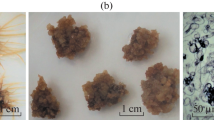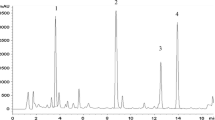Abstract
Callus and suspension cell cultures of rare foxglove species, Digitalis ciliata and D. grandiflora, were induced from cotyledons and hypocotyls of in vitro seedlings, and their growth and phytochemical profiles were investigated. In both species, callus induction was more efficient from leaf explants (60–80%) than from hypocotyl explants (15–35%). Callus cultures of both species grew well with growth indices ranged from 5 to 10 depending on the genotype. Suspension culture growth profiles also differed between the two species with a 10–11-days lag-phase observed for D. grandiflora and a bi-phasic growth curve without lag-phase recorded for D. ciliata. The main growth characteristics of the D. grandiflora suspension cell culture (maximum biomass accumulation ~ 14 g/L, growth index ~ 10, economic coefficient ~ 0.42, biomass productivity ~ 0.53 g/(L × day)) were 1.5–3 times higher than those for D. ciliata. Ten compounds were identified in cell biomass using UPLC-ESI-Q-TOF-MS: phenylethanoids digiciliside A, digiciliside B, maxoside, purpureaside E, their methyl derivatives and isomers, and two furostanol glycosides with aglycone tigogenin. Phenylethanoid glycosides were major compounds and comprised 0.8–1.1% of dry weight. During the two-years cultivation, suspension cultures retained the ability to accumulate most of the identified compounds evidencing for stability of species-specific secondary metabolism in cultured foxglove cells during this period.
Key message
Phenylethanoid glycosides (1.1% DW) and steroidal furostanol glycosides were identified in callus and suspension cell cultures of rare medicinal species Digitalis ciliata and D. grandiflora developed for the first time.




Similar content being viewed by others
Abbreviations
- α-NAA:
-
α-Naphthylacetic acid
- BAP:
-
6-Benzylaminopurine
- HPLC-ESI-MS:
-
High-performance liquid chromatography coupled with electrospray ionization mass spectrometry
- MS:
-
Murashige and Skoog medium
- SIM:
-
Selected ion monitoring
- UPLC-ESI-Q-TOF-MS:
-
Ultrahigh-performance liquid chromatography coupled with electrospray ionization hybrid quadrupole time-of-flight mass spectrometry
References
Alfermann AW, Petersen M, Fuss E (2003) Production of natural products by plant cell biotechnology: results, problems and perspectives. In: Laimer M, Rucker W (eds) Plant tissue culture: 100 years since Gottlieb Haberlandt. Springer-Verlag, Wien, pp 153–166
Arya SS, Rookes JE, Cahill DM, Lenka SK (2020) Next-generation metabolic engineering approaches towards development of plant cell suspension cultures as specialized metabolite producing biofactories. Biotechnol Adv 45:107635. https://doi.org/10.1016/j.biotechadv.2020.107635
Cai H, Wang HYL, Venkatadri R, Fu DX, Forman M, Bajaj SO, Li H, O’Doherty GA, Arav-Boger R (2014) Digitoxin analogues with improved anticytomegalovirus activity. ACS Med Chem Lett 5:395–399. https://doi.org/10.1021/ml400529q
Calis I, Akbay P, Kuruuzum A, Yalcin FN, Sahin P, Pauli GF (1999) Phenylethanoid and cardioactive glycosides from Digitalis ferruginea. Pharmazie 54:926–930. https://doi.org/10.1002/chin.200010190
Chandran H, Meena M, Barupal T, Sharma K (2020) Plant tissue culture as a perpetual source for production of industrially important bioactive compounds. Biotechnol Rep 26:e00450. https://doi.org/10.1016/j.btre.2020.e00450
Clemente ES, Müller-Uri F, Nebauer SG, Segura J, Kreis W, Arrillaga I (2011) Digitalis. In: Kole C (ed) Wild crop relatives: genomic and breeding resources, plantation and ornamental crops. Springer, Heidelberg, pp 73–112
De S, Banerjee S, Babu MN, Lakhmi BM, Babu TMS (2016) Review on cardiac glycosides in cancer research and cancer therapy. Indo Am J Pharm Res 6:5391–5400
Eshbakova KA, Zakirova RP, Khasanova KI, Bobakulov KM, Aisa HA, Sagdullaev SS, Nosov AM (2019) Phenylpropanoids from callus tissue of Ajuga turkestanica. Chem Nat Compd 55:28–31. https://doi.org/10.1007/s10600-019-02608-8
Faccin H, Viana C, do Nascimento PC, Bohrer D, de Carvalho LM, (2016) Study of ion suppression for phenolic compounds in medicinal plant extracts using liquid chromatography-electrospray tandem mass spectrometry. J Chromatogr A 1427:111–124. https://doi.org/10.1016/j.chroma.2015.12.017
Furuya T, Kojima H, Katsuta T (1972) 3-methylpurpurin and other anthraquinones from callus tissue of Digitalis lanata. Phytochemistry 11:1073–1076. https://doi.org/10.1016/S0031-9422(00)88455-1
Hagimori M, Matsumoto T, Kisaki T (1980) Studies on the production of Digitalis cardenolides by plant tissue culture I. Determination of digitoxin and digoxin contents in first and second passage calli and organ redifferentiating calli of several Digitalis species by radioimmunoassay. Plant Cell Physiol 21:1391–1404. https://doi.org/10.1093/pcp/21.8.1391
Hanrahan JW, Sampson HM, Thomas DY (2013) Novel pharmacological strategies to treat cystic fibrosis. Trends Pharmacol Sci 34:119–125. https://doi.org/10.1016/j.tips.2012.11.006
Hirotani M, Furuya T (1977) Restoration of cardenolide-synthesis in redifferentiated shoots from callus cultures of Digitalis purpurea. Phytochemistry 16:610–611. https://doi.org/10.1016/0031-9422(77)80032-0
Jin Q, Jin HG, Shin JE, Hong J, Woo ER (2011) Phenylethanoid glycosides from Digitalis purpurea L. Bull Korean Chem Soc 32:1721–1724. https://doi.org/10.5012/BKCS.2011.32.5.1721
Khandy MT, Titova MV, Konstantinova SV, Kochkin DV, Ivanov IM, Nosov AM (2016) Formation of protodioscin and deltoside isomers in suspension cultures of Nepal Yam (Dioscorea deltoidea Wall.) cells. Appl Biochem Microbiol 52:657–662. https://doi.org/10.1134/S0003683816060077
Kochkin DV, Galishev BA, Glagoleva ES, Titova MV, Nosov AM (2017a) Rare triterpene glycoside of ginseng (ginsenoside malonyl-RG1) detected in plant cell suspension culture of Panax japonicus var. repens. Russ J Plant Physiol 64:649–656. https://doi.org/10.1134/S102144371705003X
Kochkin DV, Globa EB, Demidova EV, Gaisinsky VV, Galishev BA, Kolotyrkina NG, VlV K, Nosov AM (2017b) Occurrence of 14-hydroxylated taxoids in the plant in vitro cell cultures of different yew species (Taxus spp.). Dokl Biochem Biophys 476:337–339. https://doi.org/10.1134/S1607672917050131
Kochkin DV, Khandy MT, Zaitsev GP, Tolkacheva NV, Shashkov AS, Titova MV, Chirva VYa, Nosov AM (2016) Protodioscin in Dioscorea deltoidea suspension cell culture. Chem Nat Compd 52:664–668. https://doi.org/10.1007/s10600-016-1734-0
Korkina LG (2007) Phenylpropanoids as naturally occurring antioxidants: from plant defense to human health. Cell Mol Biol 53:15–25. https://doi.org/10.1170/T772
Kreis W (2017) The foxgloves (Digitalis) revisited. Planta Med 83:962–976. https://doi.org/10.1055/s-0043-111240
Kreis W, Hoelz H, Sutor R, Reinhard E (1993) Cellular organization of cardenolide biotransformation in Digitalis grandiflora Mill. Planta 191:246–251. https://doi.org/10.1007/BF00199756
Liigand P, Kaupmees K, Haav K, Liigand J, Leito I, Girod M, Antoine R, Kruve A (2017) Think negative: finding the best electrospray ionization/MS mode for your analyte. Anal Chem 89:5665–5668. https://doi.org/10.1021/acs.analchem.7b00096
Luckner M, Diettrich B (1985) Formation of cardenolides in cell and organ cultures of Digitalis lanata. In: Neumann KH, Barz W, Reinhard E (eds) Primary and secondary metabolism of plant cell cultures. Springer, Heidelberg, pp 154–163
Lui JH, Staba EJ (1979) Effects of precursors on serially propagated Digitalis lanata leaf and root cultures. Phytochemistry 18:1913–1916. https://doi.org/10.1016/S0031-9422(00)82701-6
Lui J, Staba E (1981) Effects of age and growth regulators on serially propagated Digitalis lanata leaf and root cultures. Planta Med 41:90–95. https://doi.org/10.1055/s-2007-971682
Matsumoto M, Koga S, Shoyama Y, Nishioka I (1987) Phenolic glycoside composition of leaves and callus cultures of Digitalis purpurea. Phytochemistry 26:3225–3227. https://doi.org/10.1016/S0031-9422(00)82474-7
Mustafa NR, de Winter W, van Iren F, Verpoorte R (2011) Initiation, growth and cryopreservation of plant cell suspension cultures. Nat Protoc 6:715–742. https://doi.org/10.1038/nprot.2010.144
Müller M, Völkel W (2007) The use of liquid chromatography/mass spectrometry (LC/MS) in biological monitoring. MAK-Collect Part IV 11:3–52. https://doi.org/10.1002/3527600418.bilcmsmonite0011
Murashige T, Skoog F (1962) A revised medium for rapid growth and bio-assays with tobacco tissue cultures. Physiol Plant 15:473–497. https://doi.org/10.1111/j.1399-3054.1962.tb08052.x
Neumann KH, Kumar A, Imani J (2020) Plant cell and tissue culture—a tool in biotechnology: basics and application. Second edition. Springer Nature, https://doi.org/10.1007/978-3-030-49098-0
Nosov AM (2012a) Application of cell technologies for production of plant-derived bioactive substances of plant origin. Appl Biochem Microbiol 48:609–624. https://doi.org/10.1134/S000368381107009X
Nosov AM (2012b) Methods for evaluation and characterization of plant cell culture growth. In: Kuznetsov VlV, Kuznetsov VV, Romanov GA (eds) Molekulyarno-geneticheskie i biokhimicheskie metody v sovremennoi biologii rastenii (molecular genetic and biochemical methods in modern plant biology). Binom, Laboratoriya Znanii, Moscow, pp 386–403.
Nosov AM, Popova EV, Kochkin DV (2014) Isoprenoid production via plant cell cultures: biosynthesis, accumulation and scaling-up to bioreactors. In: Paek KY, Murthy HN, Zhong JJ (eds) Production of biomass and bioactive compounds using bioreactor technology. Springer, Dordrecht, pp 563–623
Nover L, Luckner M, Tewes A, Garve R, Vogel E (1980) Cell specialization and cardiac glycoside formation in cell cultures of Digitalis species. Acta Hortic 96:65–74. https://doi.org/10.17660/ActaHortic.1980.96.3
Perrone A, Plaza A, Bloise E, Nigro P, Hamed AI, Belisario MA, Pizza C, Piacente S (2005) Cytotoxic furostanol saponins and a megastigmane glucoside from Tribulus parvispinus. J Nat Prod 68:1549–1553. https://doi.org/10.1021/np0502138
Rucker W (1988) Digitalis spp.: in vitro culture, regeneration, and the production of cardenolides and other secondary products. In: Bajaj YPS (ed) Medicinal and aromatic plants I. Biotechnology in agriculture and forestry 4. Springer, Heidelberg, pp 388–418
Samylina IA, Yakovlev GP (2016) Farmakognoziya (Pharmacognosy). GEOTAR-Media, Moscow
Skhirtladze A, Kemertelidze E, Nebieridze V, Ganzera M (2016) Phenylethanoid glycosides from the roots of Digitalis ciliata Trautv. Helv Chim Acta 99:241–245. https://doi.org/10.1002/hlca.201500288
Skhirtladze AV, Kopaliani TA, Nebieridze VG, Kemertelidze EP, Ganzera M (2017) New steroidal glycosides from pericarp of Digitalis ferruginea. Chem Nat Compd 53:1083–1087. https://doi.org/10.1007/s10600-017-2206-x
Tomilova SV, Kochkin DV, Tyurina TM, Glagoleva ES, Labunskaya EA, Galishev BA, Nosov AM (2022) Specificity of growth and synthesis of secondary metabolites in cultures in vitro Digitalis lanata Ehrh. Russ J Plant Physiol 69:149–160. https://doi.org/10.1134/S1021443722020200
Verma SK, Das AK, Cingoz GS, Gurel E (2016) In vitro culture of Digitalis L. (foxglove) and the production of cardenolides: An up-to-date review. Ind Crops Prod 94:20–51. https://doi.org/10.1016/j.indcrop.2016.08.031
Wu T, Kerbler SM, Fernie AR, Zhang Y (2021) Plant cell cultures as heterologous bio-factories for secondary metabolite production. Plant Comm 2:100235. https://doi.org/10.1016/j.xplc.2021.100235
Zaripova AA, Ahmetova AS, Muhametvafina AA (2015) Study of the morphogenesis of Digitalis grandiflora Mill. in vitro culture. Agrar Ross Mol Biol Biotekhnol 1:20–25. https://doi.org/10.30906/1999-5636-2015-1-20-25
Zhou BN, Bahler BD, Hofmann GA, Mattern MR, Johnson RK, Kingston DG (1998) Phenylethanoid glycosides from Digitalis purpurea and Penstemon linarioides with PKCalpha-inhibitory activity. J Nat Prod 61:1410–1412. https://doi.org/10.1021/np980147s
Acknowledgements
The research on development and maintenance of cell cultures was financially supported by the Ministry of Science and Higher Education of Russian Federation through Megagrant project no. 075-15-2019-1882 and performed using the equipment of the large-scale research facilities “All-Russian Collection of cell cultures of higher plants” and “Experimental biotechnological facility” of the Institute of Plant Physiology of Russian Academy of Sciences. The results of cell culture growth assessment and phytochemical analysis were obtained within the state assignment of Ministry of Science and Higher Education of the Russian Federation (themes no. 121041200194-7 and 121050500047-5, respectively).
Funding
The authors have no relevant financial or non-financial interests to disclose except of the financial sources mentioned in the Acknowledgements.
Author information
Authors and Affiliations
Contributions
SVT—development and cultivation of callus and suspension cell cultures, determination of growth characteristics, preparation of extracts for quantitative phytochemical analysis, manuscript writing and editing; DVK—qualitative and quantitative phytochemical analysis, manuscript writing and editing; TMT—preparation of extracts for qualitative phytochemical analysis; ESG—development and cultivation of callus cell cultures, manuscript editing; EAL—development of callus cell cultures; BAG—qualitative phytochemical analysis; AMN - experiment planning and supervision, fund acquisition, manuscript writing and editing.
Corresponding authors
Ethics declarations
Conflict of interest
The authors have no competing interests to declare. All authors certify that they have no affiliations with or involvement in any organization or entity with any financial interest or non-financial interest in the subject matter or materials discussed in this manuscript.
Additional information
Communicated by Wagner Campos Otoni.
Publisher's Note
Springer Nature remains neutral with regard to jurisdictional claims in published maps and institutional affiliations.
Supplementary Information
Below is the link to the electronic supplementary material.
Rights and permissions
About this article
Cite this article
Tomilova, S.V., Kochkin, D.V., Tyurina, T.M. et al. Growth and biosynthetic profiles of callus and suspension cell cultures of two rare foxglove species, Digitalis grandiflora Mill. and D. ciliata Trautv.. Plant Cell Tiss Organ Cult 149, 213–224 (2022). https://doi.org/10.1007/s11240-022-02271-y
Received:
Accepted:
Published:
Issue Date:
DOI: https://doi.org/10.1007/s11240-022-02271-y




